



|
|
|
|
|
TOUR NEWS
OCTOBER 2005 - APRIL 2006 THE APRIL 2006 TOUR OF TUNISIA AND LIBYA
The inaugural Roman North Africa tour in April was a great success with no major difficulties - we certainly saw an incredible amount with most days very full and all felt we needed a holiday by the end. The group consisted of 16 people and included: Patricia Ball, Steven Darlow, Brenda Garde, Vesna James, Peter and Erica Norris, Kerry and Janet Peadon, Lidia Peruzzi, Caroline and Bryan Riddell, Philippa Shaw, Chris and Kim Shephard, Robert Snow, Isobel Stening. The tour leader was Dr Michael Birrell. We started our program in Tunis having flown via Cairo on Singapore Airlines. One of our group, Bob Snow, was already in Tunisia and gave us a warm welcome. The following day we went to see the ruins of Carthage - we started on the Bursa Hill where we toured the old Punic houses and Museum, then stopped to see the Roman amphitheatre and cisterns, and saw the Punic Tophet cemetery and harbours. In the afternoon, after a great seafood meal, we had a walk around the scenic seaside Sidi Bou Said shopping district. We spent a few days in Tunis visiting a number of highlights in the area. This included the Bardo Museum with its superb collection of Punic artefacts and Roman mosaics. The following day we had a walk through the old Muslim quarter of Tunis (I soon realised how difficult it was going to be to get the entire group past the enticing shops as we headed for the Great Mosque!). Lunch was spent in a very beautiful restored merchant's house. The next day we went by bus to see the very picturesque ruins of the Punic city of Kerkouane, located on the seashore east of Tunis. We had a superb fish lunch by the sea and then toured the old Punic quarries at Houaria. We left Tunis and headed west. We stopped to see Carthage's aqueduct and then headed on to Thuburbo Majus, a sprawling Roman town in ruins. We then headed into the hills to see Dougga, a remarkable ruined city with spectacular outlook. We saw much more of the site than most tourists including the magnificent temples of Saturn, Juno and Jupiter. In the late evening we headed to Le Kef which was to be our base for the next few days. From here we went north to see the underground houses and mosaics of Bulla Regia, enjoying a picnic lunch in the Roman baths. The following day was spent walking around the town of Le Kef enjoying the beautiful sunny weather as we saw the Turkish fort and ethnographic museum. Then we travelled south to Sufetula where we saw the magnificent Roman ruins, the highlight being the famous Temple of Minerva. 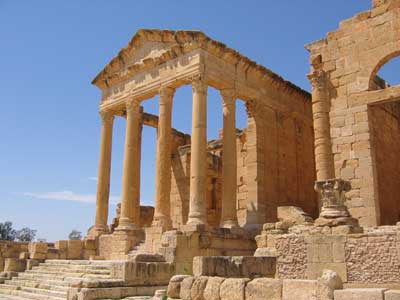 Exploring the ruins of the temple of Minerva at Sufetula
We then travelled east towards the coast, stopping at the medieval city of Kairouan before arriving in Sousse where we stayed for an extended visit. We resided in the comfortable Sousse Palace Hotel next to the sea and did a number of day trips. On arrival we celebrated the combined birthday of Caroline and Bryan Riddell with a seafood feast. On one day we saw the Roman mosaics in the local museum and walked through the medieval city to visit the Great Mosque and a merchant's house - again more tempting shopping opportunities for the group! We climbed the watch tower for a panoramic view of the city. We then visited the magnificent Roman amphitheatre at el-Jem and saw the local museum, endowed with more breathtaking mosaics. We then travelled on to Libya. The country has yet to come to terms with mass tourism but will soon see large scale development of its facilities. Flights in Libya are always something of an adventure with a typically Arab state of laisee faire and chaos at the airport. Despite some uncertainty about whether we would all get a seat on the plane (they had overbooked of course!), we eventually checked into a hotel in Benghazi. The following day we travelled east by bus, stopping to have a look at the Hellenistic and Roman ruins at Ptolemais. We had a delightful picnic lunch under the eucalypts and bargained for Colonel Ghaddafi watches. That evening we checked into our hotel in el-Beida where we stayed a few nights. The following day we went to see the superb ruins of Cyrene, an enormous site on three levels looking over the plains. We had the time to really explore the magnificent Forum, the Agora, and the sacred enclosure of Apollo. After a pleasant lunch we head down to see Apollonia, the old port of Cyrene, with its picturesque churches and theatre overlooking the sea. The following day we went back to Cyrene to see the museum with its astonishing and breathtaking collection of Roman sculpture - we then had a delightful morning exploring the area around the enormous temple of Zeus, enjoying the spring weather and carpets of wild flowers. We made our way to Benghazi for our flight to Tripoli and checked into our hotel near Leptis Magna. Being close to the site enabled us to spend more time exploring this unique ancient place. The following day was pretty tiring as we all wanted to see as much as possible - we spent about 7 hours wandering around, exploring the Baths of Hadrian, the Forum and Basilica of Septimius Severus, the theatre, Old Forum and lighthouse before walking back to our hotel along the beach. A refreshing paddle was much appreciated and an ice cream was eventually our reward for all our efforts. The next day we went back to Leptis Magna to see the Museum and then saw the impressive amphitheatre and circus racetrack. It was a cold windy day but that did not deter us from our adventures. In the afternoon, we stopped to see the old Roman villa at Sileen with its superb frescos and mosaics. The last few days of the tour were spent in Tripoli. We saw the National Museum with its impressive collection of Roman sculpture and also walked through the old city. Our last day in Libya was spent touring the Roman ruins at the seaside location of Sabratha. The highlight was undoubtedly the reconstructed Roman theatre with its enormous colonnaded stage. 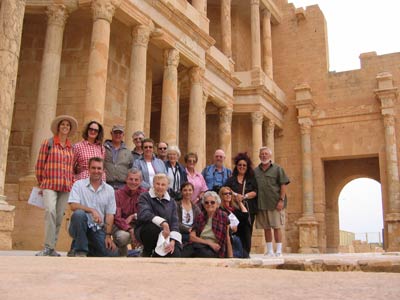 The April 2006 group in the Roman theatre at Sabratha
A SHORT EXCURSION IN ITALY
A dedicated group continued our adventures in Italy for 4 nights: this included Kim and Chris Shephard, Bryan and Caroline Riddell, Vesna james, Philippa Shaw, Steve Darlow, Isobel Stening and Lidia Peruzzi. We were also joined by Ian and Diane Casey. We travelled from Rome International Airport south to Naples where we saw the ruins of Herculaneum. A rain shower managed to deter most tourists, and when the clouds cleared we almost had the place to ourselves. We took the entire afternoon looking at the houses before heading to our Naples Hotel. The following day was spent in Pompeii. First thing in the morning we went to see the Roman farmhouse at Boscoreale with its fascinating collection of objects of daily life. We arrived in Pompeii about 11am and spent the rest of the day (7 hours!) wandering around the site. We explored the Forum and then walked up to the Villa of the Mysteries. From here we walked along the walls of the city and down to the theatre area. Late in the day we travelled back to Rome, exhausted but content that we had really seen everything. 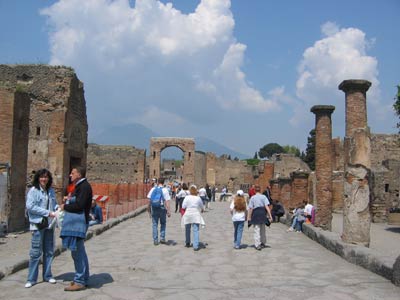 Exploring the ruins of Pompeii
We then had two days in Rome - this gave us the opportunity to do some walking tours of the city. We saw the Ara Pacis (shrine of Peace built by Augustus) in its brand new museum which opened the day we arrived. We also walked through the Campus Martius. In the afternoon we saw the superb collection in the Palazzo Massimo. The following day we went for a walk through the Roman and Imperial Forums and saw the Colosseum. THE JANUARY 2006 TOUR OF EGYPT
The January 2006 tour of Egypt had as its theme Ramesses the Great and we mainly looked at monuments of the 19th and 20th Dynasties (1300-1100 BC). The group consisted of 17 enthusiastic participants which included: Alex Bremner, Ann and Ian Brown, Michael and Margaret Coady, Daniel Glancy, David Keys and Janet Prott-Keys, Ken Lee, Antony Mawer, Lesley Pinnington, Heidi Sinclair, Viriginia Waite, Katherine, Victor and Carol Winterfeldt and Carolyne Zietsch, The tour was led by Dr Michael Birrell who was assisted by Amr Mohamed. Our first day was spent at the Cairo Museum having a relaxed wander around the collection and trying to recover from our flight from Australia. The following day we headed off to Saqqara to see the Step Pyramid. We made a valiant attempt to view the tomb of Horemhab near the Unas Causeway (not normally open to tourists) but were chased away by police on camels! That certainly made for an interesting start to the tour! The following day we headed north from Cairo to visit the sites of Bubastis and Tanis, Delta cities that were homes to the kings of the Third Intermediate Period. We enjoyed walking around the ruins of the site of Tanis where and were treated to a recreation of a scene from the Indiana Jones film 'Raiders of the Lost Arc' - a beam of sunlight showed us the location of the Well of Souls where the Ark of the Covenant was hidden! The following day we went to Giza - quite a few members of the group disappeared into the desert on camels perhaps never to be seen again. The following day we headed south to Luxor by plane and checked into our comfy 3-star hotel the Nile Valley Hotel. Some of us had lunch at the Winter Palace, the grand old hotel of Luxor, and pretended we were staying there. One evening we went for a relaxing Felucca ride on the Nile to watch the sunset and the ever changing activities on the River. The week we spent in Luxor was full of 'Wonderful Things'. We visited the Valley of the Kings to see three royal tombs and also stopped in to see the very fine temple of Sety I. The picturesque Ramesseum, mortuary temple of Ramesses II and the workers village at Deir el-Medina were popular excursions. A visit to Luxor Temple in perfect winter sunshine was by consensus one of the highlights. 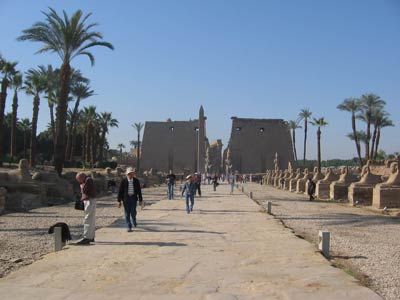 Exploring the temple of Luxor
The following day we crossed the river on the ferry and then caught the bus north to see the ruins of the temple of Sety I at Abydos. Everyone enjoyed the superb wall paintings in the main temple and then we crossed the desert to have a quick look at the equally fine temple of Ramesses II. On the way back to Luxor we stopped at Dendera to wander in awe at the colossal pronaos of the Temple of Hathor. The following day we spent most of the day wandering around the dramatic ruins of Karnak, home to the cult of Amun-Re. No one can see this temple and not be impressed by the enormous dimensions of the hypostyle hall, or be entranced by the dimly lit statue of Hathor in the Temple of Ptah. That evening we took a carriage ride through the streets of Luxor to a new restaurant called the Sofra Restaurant, and enjoyed a very pleasant meal (even if there was no alcohol available!). The carriage drivers elected to have a race down the street on our way back to our hotel which left our hearts racing as we hung on for dear life. Our final day in Luxor was spent at Medinet Habu, one of the most beautiful places in Egypt (and my personal favourite!). We had frequently had lunch opposite the temple while exploring the West Bank at Luxor and now finally we went inside to see the superb wall paintings. Next we headed to the Valley of the Queens to see three of the spectacularly panted royal tombs. The following day we went by bus to Aswan, stopping along the way to see the Temples of Edfu and Kom Ombo. This entailed an early start but we all enjoyed the sight seeing and had late lunch in Aswan over looking the Nile while watching the feluccas sail by. In Aswan we stayed at the Marhaba Hotel at the northern end of the city - it has a beautiful view across the river to the tombs of the Nobles, and a pleasant roof terrace. The sunsets were particularly spectacular perhaps aided by the consumption of a number of lime vodkas and G&T's. In Aswan we visited the Island of Philae to see the remarkable Temple of Isis. En route some members of the group were overwhelmed by the shopping opportunities and had to be reminded that the temple was hoving into view! We also visited the granite quarries and went to the Nubia Museum. A pleasant afternoon was spent at the Nubia House Caf� with spectacular views over the river as the sun went down over the First Cataract. Our last day in Aswan entailed climbing the rock steps to the Nobles Tombs - the stairs definitely reminded some of us that we had been eating far too much baklava! A quiet afternoon felucca ride and lunch on an island was much appreciated. 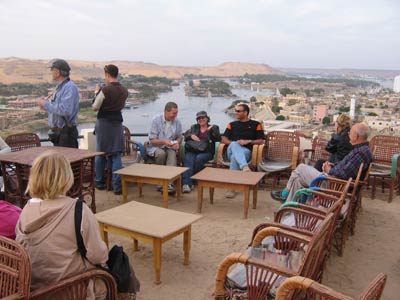 Afternoon tea at the Nubia House restaurant - First Cataract at Aswan
The following day we flew down to Abu Simbel and checked into our cruise boat - the Kasr Ibrim. We saw the rock-temples and then saw the 'sound and light' show which was good fun. The next few days were spent travelling on Lake Nasser - the weather was un-seasonably overcast and cool but we enjoyed our visits to the temples on our way back to Aswan. A camel ride at Wadi es-Sebua across the desert was a highlight though a camel managed to tread on Heidi's camera - no damage done however thank goodness! 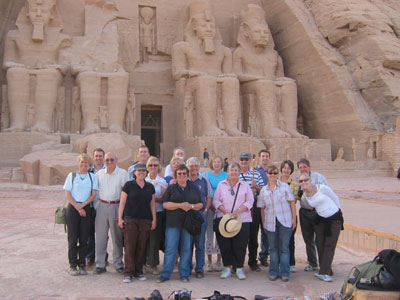 The January 2006 group at Abu Simbel
In Cairo we went for a walk through the Islamic quarter and in the Cemetery of the Dead climbed to the top of the minaret of the Tomb of Barquq. We also returned to the Cairo Museum and enjoyed its many wonders. THE OCTOBER 2005 TOUR OF EGYPT
The first program of this tour season was a tour of Egypt looking at its history and archaeology. The group was a relatively small one and included: Elicia Cosentino, Jessica Mayers, Paula Nason, Allan Stuckey and Gilliane Tedder. The tour leader was Dr Michael Birrell and the Egyptian guide was Amr Mohamed. The tour began with a few days in Cairo where we spent time looking at the pyramids and mastaba tombs at several sites. We arrived in Cairo early in the morning and after a hearty breakfast made our way to the Cairo Museum to have a first look at the wonderful collection. We stayed at the good old Pearl Hotel in Maadi, a very comfortable and quiet little hotel in the suburbs of Cairo. The following day we headed to Saqqara to see the Step Pyramid. We had perfect clear weather and Gillian went for a donkey ride around part of the site. We next visited Meidum, site of the ruined pyramid of King Sneferu. We went into the pyramid itself and some were also game for crawling down the robber's tunnel into the nearby Mastaba to see the stone sarcophagus of the owner. At Dahshur we went down into the multiple chambers of the pyramid and enjoyed a superb view north towards Saqqara. Afternoons were generally spent having a beer down by the Nile. The following day we went to Giza and enjoyed a walk round the site and a camel ride. The view from the lunch time restaurant was spectacular with direct views of the Sphinx and Pyramids. The afternoon was spent exploring the Khan el-Khalili markets. 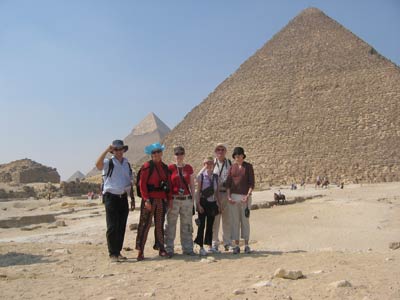 The October 2005 group at Giza
We then flew south to Luxor and checked into our 3-star hotel near the river called the Nile Valley Hotel. Located on the west bank, it is very convenient for the antiquities and a short ferry ride to the centre of town. Our first day was spent walking across the Theban Hills, with superb views down onto Deir el-Medina, the ancient village of the workmen who built the royal tombs. We stopped to look into the Valley of the Kings, and spent the afternoon in the mortuary temple of Queen Hatshepsut. A day was spent in the ruins of Karnak temple exploring the wonders of the largest temple in Egypt. One cannot help but be humbled by the scale of the monuments. In addition, we explored other ruins on the West Bank including Deir el Medina, the village of the workmen, the Ramesseum and the temple of Ramesses III at Medinet Habu. 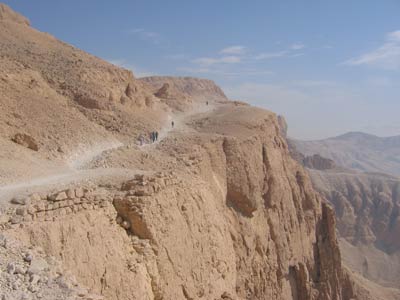 Our walk across the Theban Hills in the morning mist
The group then travelled south to Aswan by bus - en route we stopped to see the enormous temple of Horus at Edfu and the ruins of Kom Ombo. A highlight of the trip was a serene boat ride on the Nile. We also saw the tombs of the Nobles, visited Philae to see the Temple of Isis and went on a camel ride across the desert at sunset to see the ruins of the Monastery of St Simeon. Back in Cairo we explored some of the wonderful mosques in the old quarter and went back to the Cairo Museum for a longer look. |